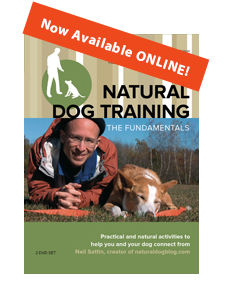I'm about to have some houseguests arrive, and they'll be here for a few days. Why am I telling you this, you ask? Well, it turns out that they have a black lab mix - he's young, a bit spastic, and he has been known to be aggressive with other dogs. So, in the interests of everyone being able to get along for the next 5 days, I am dusting off the old manual to tell you about the best way to introduce two dogs to each other. These are the basics of introducing your dog to another dog. In an upcoming article we will talk about specific strategies to handle severe aggression between two dogs. If you were to rate dog aggression on a scale of zero to ten, with ten being the MOST aggressive (and zero being not aggressive at all), these techniques will work with dogs in the zero-to-six-or-seven range. Dogs in the eight-nine-ten range...well, they deserve a special article all to themselves. So, without further ado, here is the best way to introduce your dog to another dog, in ten easy steps:
- Make sure both dogs are on a leash. You want to have complete control over the situation. Even if you have a dog who "generally does better off-lead than on-lead" (I put this in quotes because I hear this very often from clients), there is no guarantee that the other dog is going to do well - and without a leash on your dog you'll have no way to pull them apart should either one decide to attack. So do yourself and everyone else a favor...leashes, please.
- Take the dogs on a walk "together" - single file. Your temptation will be to let the dogs meet and sniff each other first. Don't do that! The reason that it's often a bad idea is that as two dogs approach each other the emotional intensity runs VERY high - so it is the most risky time in doggy introductions. You and the other person should decide which direction you're going to walk in, and one of you should start off in that direction, with the other person following. Let's assume that the other person starts, so you're the one following behind, for the time being.
- Praise your dog, no matter what they do. Your goal is to help your dog (and the other dog) RELAX in this situation. The only way you are going to do that is by being a supportive, calming voice/presence for your dog. Any barking that they are doing is just their way of letting out steam. As you move on the walk, you will be letting the steam out in a positive way - teaching your dog an alternative to barky spastic-ness and aggression. Think of yourself as saying "good dog, thanks for letting me know how you're feeling right now".
- Keep it moving. As I mentioned earlier, one of the most difficult aspects of a dog-on-dog introduction is the emotional intensity between the two dogs. If they are focused exclusively on each other, there is no way for this energy to dissipate (unless you're lucky and they just start playing together, which is the way that two HEALTHY dogs handle the intensity). As long as you can keep walking, you can keep the energy of the situation moving, and make it much less intense for your dogs. Instead of them being both "about" each other, they will be "about" the walk they are taking - which is like them being on the hunt together. Yup, you are stimulating their hunting nature, which, as you may recall from this earlier article about being calm, assertive, and mooselike, is when dogs are the MOST social.
- Slowly let them sniff each other as they are walking. Since you are following, it will most likely be your dog that makes the first sniff - in the rear of the other dog. Hey, that's what dogs do! Remember that utilization of the olfactory sense is an indicator that your dog is transitioning into hunting mode, so it's a good sign. There may be a slight pause in the action, which is ok (still, though, try to keep it moving). The dog being sniffed will be reacting as well, so both owners need to be vigilant about what's going on. After the trailing dog sniffs the forward dog it's generally a good idea to trade positions, so that the dog who just got sniffed has a chance to do the sniffing. At this stage you want to avoid to much stand-still (which can lead to confrontation), so just move past the other dog, get the walk moving again, and THEN let the other dog move in for their turn to sniff. Keep taking turns with each dog having repeated opportunities to be in the lead over the course of the walk.
- If one dog poops or pees, let the other dog sniff it - after the dog doing the pooping/peeing is DONE. Make sure you move the excretor away before you let the other dog into sniff. The sniffing of poop and urine is an important exchange of information and energy between the two dogs. Think of it as a non-verbal way of communicating. Once the two dogs are eliminating in each other's presence, that's a very good sign that the dogs are getting used to each other.
- Watch for signs of play between the two dogs. If one dog makes a play bow, that's an EXCELLENT sign. You will be tempted to just let the dogs play with each other at this point - but NOT YET. For one, if they're still on leashes that you're holding then you are running the risk of them getting tangled and the excitement of the moment turning into a fight. If they're free to run, you're still running that risk - so keep walking, give them a chance to chill out a little bit, and be happy that they're showing you signs that they'll be able to get along.
- If you know how to "push" with your dog, take breaks to do that - or play tug of war. This is a step I'll address more when we talk about more "heavy-duty" aggression. Remember that pushing with your dog is a great way to help reduce the amount of stress that they're feeling, and also to give them a positive outlet for their energy. Make sure that you move the dogs away from each other to do this - you don't want there to be any food-induced aggression between them. Playing tug-of-war with your dog is another way to give them an outlet in a high-energy moment, just make sure that you let your dog win. You'll need a treat so that you can trade the treat for the tug toy when you're done playing and ready to get back to the walk.
- Also take breaks and give the dogs long, slow, massaging strokes down the length of their body. Your goal is to get your dog as PHYSICALLY relaxed as possible, so imagine that you're a massage therapist in charge of giving your dog the greatest degree of physical relaxation possible. Read this article on how to relax your dog for more information on this and other ways to relax your dog.
- After you've been walking for awhile, and the dogs have had a chance to sniff each other repeatedly, move so that you're walking next to each other. It's not important for the dogs to be right next to each other (in other words, you can be between your dog and the other dog). What do you want, however, is for all of you to be walking next to each other - it will give the dogs a chance to experience more direct contact between the two of them while keeping them aligned with a common purpose - the walk (aka the hunt).
That's it! Plan on walking together for at least 30 minutes, if you have the time. You are teaching the dogs a healthy way to deal with the stress of getting to know each other. The way that two healthy dogs will handle that stress is through the dynamics of play - but "play" isn't a necessary component by any means. In other words, after the walk it's not important for the dogs to have "free time" to play with each other - through your walk you just gave your dogs a perfect opportunity to get to know each other in as stress-free a manner as possible. After a successful walk, they should be relaxed and able to handle being INDOORS in each other's company. Just remember to keep the indoor environment as relaxed and low energy as possible.
As always, thanks for stopping by, and if you have any questions, feel free to leave them in the comments or e-mail me: neil at naturaldogblog dot com.





Hi there!
Thank you so much for this information about introducing dogs! I will tell you our situation because we have a follow up question.
We have a dog, Audrey, 5 yr old English Bulldog, and have just gotten two Boxer puppies, Mike and Earl, who are 12 weeks old. We took them all to the park and followed this technique exactly, and it has gone so well! Audrey was certainly interested in them, and kept turning to look at them but now they walk together with no problems at all. We have done this training about 6 times, the last two were done on our (quiet) road, where Audrey always goes on her walks.
We are very very cautious of introducing these two dogs because of what happened with Audrey and our last Boxer, Molly. Audrey and Molly had a very bad first meeting, we didn't realise how important it was and what effect it would have. Molly died 6 months ago of cancer, but for Audrey's 5 years with us we had to keep them separated in the house. They had heaps of fights, they would tolerate about 20 mins in the same room and then have a violent fight.
OBVIOUSLY we don't want this to happen again!!! We decided on getting boy dogs, so there would hopefully be less rivalry.
We've had them sitting comfortably with each other in the yard, but all on leashes. The pups are VERY enthusiatic, and want to play with Audrey. There has been a few times on our walks when they have lunged at her to play, and she will do a small snap of her teeth in their direction. We feel like this is a fine response to them, but I worry about what would happen if they jump at her without leashes. She has unfortunately not been a well socialised dog.
Really my question is about what the next step is in introducing these dogs. I have found this web page: http://www.wikihow.com/Introduce-a-New-Dog-to-Your-House-and-Other-Dogs
and it seems to make sense to me. Do you have any comments or ideas? I really respect your ideas, because this particular article of yours has made a complete turnaround in Audrey's behaviour.
I'd love to hear from you on this,
Thanks,
Meg Campbell
Hi Meg,
I'm glad to hear of your successes and the turnaround with Audrey. I checked out that web page, and it seems fine enough - though as you have noticed I think it's important for all introductions to happen OUTSIDE. So while it's fine (in that it raises your awareness about dog-to-dog issues), I'm not sure how much people would need to worry about all that if they follow the steps I've outlined. Always good to be informed, though, to be sure.
Regarding Audrey's "snapping" - without having seen it, I can't tell you. That would PROBABLY be a completely appropriate way for Audrey to tell the pups to "cool it" - and an effective way to communicate such an emotion (rather than going all ballistic). One thing that article mentions that IS very valuable is recognizing that the pups are generally quick to adjust to new situations, so most of your efforts should focus on keeping Audrey relaxed. So while you're working with the pups, make sure that you take time with Audrey to address HER prey drive - especially when she's been interacting with the pups (and probably has some stress stored up that she needs to vent). Working with Audrey alone to do pushing/tug plus massage and other relaxation techniques to help her work through the stress of the situation, and praising her no matter what her response to the pups is.
For in fact, giving "voice" to her concern with the pups IS a good thing - especially if it serves its purpose without the need (as Audrey sees it) for further escalation.
Let me know if you have further questions, and keep up the good work!
Hi Neil. As I am new to computer land, I have some how over looked your site. I am deep into this type of training an am SOOO Happy I found you. I feel that you are More Explanitory than most training sites, even Cesar. He is Very Good, but somehow seems as though he leaves you 'Guessing' on "what did he do" situations. I have been training my own dogs all my life and found the book "How To Be Your Dog's Best Friend" by the Monks of New Skeet, and have been using that technique since. I found Cesar on 'NGC's "Dog Whisperer" and got interested in his way of doing things, but have always been left with 'What did he do exactly', after watching him on TV. I believe that you are More Detailed in your descriptions than he is. I have now got your site in my Top Favorites possisition and will defenitely return often. I am disabled as far as being able to do 'hard' work due to an old injury that is causng deterioration to my joints and spinal disk, but I still (so far) get around and LOVE to work with dogs. I now have a Jack Russell for my companion, but I will try to donate when at all possible. Just from what I have read tonight, I know I will be back "A LOT" and look forward to learning even more from you.
Thanks for being there, I'm sure there are a lot of others out there who think as I do.
Very Appreciative,
Lester Salings
Bowling Green, Ky.
Hi Lester. I'm glad that you're finding the site to be helpful, and thanks for the feedback!
Hello,
I had just read your article about introducing two new dogs to each other and I have a question. I have a 1 1/2 year old Rottweiler male and I rescued him from a local shelter. I would love to have him interact with other dogs but because of the breed I'm not sure if he would give a warning before he would attack. Therefore, I'm afraid to let him meet othwer dogs.
I went to the vet and there was a smaller dog there and he kept running towards him wanting to sniff. Of course i didnt allow cause the woman holding the little dog would have had a heart attack.
How do i solve this problem?
Thanks,
Magie
Suffolk County, NY
Hi Magie,
Thanks so much for your question. I decided to devote a blog post to the answer, which you can find here:
More information on introducing two dogs
Hope this helps you!
Hi Neil,
This weekend my new partner and I are planning on introducing our dogs. We have discussed this in depth, as we want the experience to be as calm as possible as at the meeting will be my dogs - a labXmalamute desexed male 7yo and a malteseXshitzhu desexed male 2yo, and my friend has a 5yo bull terrier desexed male and a 3yo female bull terrier. We will be following your guidelines, but do you have any other suggestions that may help? I will let you know how things go
Thanks
Lyndal, Australia
You might want to just ensure that you keep it manageable for yourself by introducing the dogs to each other one at a time - which will ensure that you're able to focus on the individual needs of each dog as you help them through the interactions. Don't try to do them all at once. Maybe also space out several "introductions" over the course of a few days, giving your dogs some space to decompress after the encounters. Depending on how it's going, you might want to also let them play together in groups of two, then three, before you let all four of them together. Keep me posted, and if anything comes up about which you have further questions, feel free to ask away.
Just wanted to let you know this article inspired me to start a "Dog Walking Club" using your pointers. I found some interested folks who are willing to join me on what I hope to be a regular gathering.
Thanks! and keep up the great work!